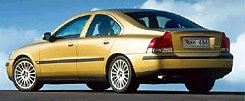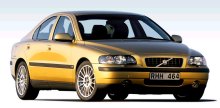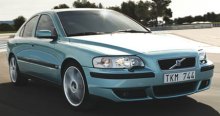|
Volvo S60
Debut: 2001
Maker: Volvo
Predecessor: S70 (1997)
|
|
 From
pictures, S60 could be one of the most attractive designs for years.
Look
at that coupe-like fastback ("a la 4-porte coupe"), the
beautifully-tailored
multi-plane C-pillars, the S80-inspired shoulder lines and stair-like
tail
lights ... the whole design is simple and pure yet sexy and unique. The
Swedish have the German beaten here. Audi also called its A6 as "4-door
Coupe", but unlike this Volvo, it never convinced me. From
pictures, S60 could be one of the most attractive designs for years.
Look
at that coupe-like fastback ("a la 4-porte coupe"), the
beautifully-tailored
multi-plane C-pillars, the S80-inspired shoulder lines and stair-like
tail
lights ... the whole design is simple and pure yet sexy and unique. The
Swedish have the German beaten here. Audi also called its A6 as "4-door
Coupe", but unlike this Volvo, it never convinced me.
Volvo
sees it as a new revolution not unlike S70 - somewhat its predecessor -
did in 1993. The company uses the term "REVOLVOTION" describe it
because
it intends to bring first-ever good dynamic to the company renowned for
boxy estates and crash safety. S70 (nearly forget it was called 850
then)
was the first Volvo trying to do so, and with considerable success, but
it was never up to the German game. Now S60 is going to play with BMW
3-series,
Mercedes C-class and Audi A4 directly.
If
you have seen it on road, you might find the real car doesn’t look as
attractive
as in photos, blame to the over-long and over-wide proportion. Yes, S60
is much wider and has longer overhangs than its established rivals,
this
is because it was derived from the big S80 and V70. As it was designed
well before Ford entered the scene, this is the only way to develop it
in a small budget. All engines, gearbox, suspensions and the front
subframe
that holds them are carried over from its sisters, so you can see how
cost-effective
it is. The down side is - as admitted by Volvo’s engineers - higher
production
cost. If they were given a second chance, they would have started from
the V70 rather than the more expensive S80.
If
you have read my V70 reports, you can skip this paragraph. The S60 is
powered
by all 5-cylinder engine ranges. The Porsche-designed modular engines
can
be dated back to the 850 and 960-era. As in V70, there are various
derivatives
on offer: 140hp 2.4 sohc, 170hp 2.4 dohc, 180hp 2.0 HPT (stands for
"high-pressure
turbo"), 200hp 2.4 LPT (undoubtedly, stands for "low pressure turbo")
and
the fire-breathing 250hp 2.3 turbo for T5 model. The 2.4 LPT is
particularly
lovely because of its smooth and lag-free manner. Peak torque arrives
at
just 1800 rpm. The turbo of T5 is also well sorted after so many years
of improvement. It provides a good balance between performance and
tractability,
in other words, is quite linear and has little turbo lag considering
its
100hp/litre-excess output.
 Launch
the S60 T5 in straight line and BMW 330i could be scared if his driver
does not make 100% effort. Apart from some wheelspin at 1st gear, the
Volvo
reaches 60 mph in 6.8 seconds, and reach the tone at 17.5 sec. Most
important
is that its driver does this effortlessly, unlike the sweating 330i
driver.
In terms of sound-track, the unique 5-cylinder growl loses nothing to
the
Munich straight-six, making you wonder why Audi no longer builds
inline-5. Launch
the S60 T5 in straight line and BMW 330i could be scared if his driver
does not make 100% effort. Apart from some wheelspin at 1st gear, the
Volvo
reaches 60 mph in 6.8 seconds, and reach the tone at 17.5 sec. Most
important
is that its driver does this effortlessly, unlike the sweating 330i
driver.
In terms of sound-track, the unique 5-cylinder growl loses nothing to
the
Munich straight-six, making you wonder why Audi no longer builds
inline-5.
The
chassis is rock-solid, some 70% stiffer than S70 and is the stiffest
among
sister cars. T5’s suspension setting is firm but all the damping,
springing
and bushing are better sorted out than both V70 and S80, therefore
while
it rides firm it still cover ground smoothly - much more supple than A4
at least. Body control is as good as rivals. There are some inherent
shortcomings
of course - front-wheel drive and nose heavy - but the suspension
modifications
really did the job, no torque steer at all unless accelerating hard out
of corners. Yes, steering feel is inevitably corrupted a bit, but
objectively
it is accurate and well-weighted. Therefore S60 is undoubtedly the best
driver’s car in Volvo’s history, and it nearly matches the German
premium
rivals.
However,
for pure fun of handling, this Volvo is not my choice. What makes S60
attractive
is its unique character. Apart from styling and effortless performance,
it shines in comfort as well. The designers made a miracle to provide
coupe-look
and plenty of rear seat space (both head and leg) simultaneously.
Interior
styling mirrors that of S80, which is undoubtedly a good thing.
Driver-biased
center console injects extra sense of sporty, while ergnomics and
styling
are second to none. Plastics, however, is not yet German-class, but
neither
do the German cars provide the stylish "space ball" shifter cover -
though
it’s purely cosmetic. Front seats are in the best Swedish tradition -
comfortable
yet beautifully shaped.
I think
I am a little bit in love with S60. It’s not perfect - C320 and 330i
are
still better all-round - but it is characterful and beautiful. In the
days
that Mercedes, BMW and Audi looks, smell and drive similar, this Volvo
could stand out of the crowd. Volvo is now working on a hotter version
with 300hp and Haldex 4WD, the latter could fill the last missing ring
of the S60. |
| The
above report was last updated on 2 June
2001. All Rights Reserved. |
S60 D5
|
Undoubtedly,
all modern common-rail or pump-injection turbo diesel engines can be
praised
with these phrases - "very frugal", "nearly as refined and quiet as
petrol",
"very torquey from rev barely over idle", "superior overtaking
performance
than the petrol version" and "best buy of the range" etc. etc. Having
memorized
these phrases, you can write about just any modern diesel cars without
the risk of being discovered that you are not a real car journalist.
So,
to write about new diesels is quite easy but boring, isn’t it ?
Not
for the Volvo D5 engine. Admittedly, all the above phrases still apply
to it, but it is very unusual compare with other diesels. For noise and
vibration suppression, most diesels are specially designed thus shared
little with petrol engines, especially are stronger cast-iron blocks.
The
Volvo is not. It is derived directly from the inline-5 petrol engine
appeared
since the early 90s. In other words, it employs aluminium block and
head,
twin-cam and 20 valves. Weighing at just 185kg, it adds just 40kg to
the
kerb weight compare with the petrol equivalent. Of course, that weight
still deteriorates a bit steering response, but so does all diesel cars.
Alloy
engine would have been noisier than cast-iron, but Volvo reinforced it
such that it is just as refined as any rivals. In terms of power
delivery,
it is even more refined than most. VTG (Variable Geometry Turbine)
turbo
is not a unique feature to Volvo, but compare with other VTG-equipped
rivals
the Volvo D5 delivers its power more smoothly and linearly as rev rise.
It is also more free-revving and throttle-happy, thanks to lightweight
pistons. A sporty exhaust growl further lifts driving pleasure.
From
1750 to 3000rpm, the 2.4-litre common-rail turbo diesel produces a
maximum
torque of 250 lbft which beats even a T5. At 4000rpm it pumps out the
peak
power of 163 hp, equaling a petrol and supercharged Mercedes C200K. At
the same time, it returns a remarkable 47.1mpg in combined cycle. In
many
ways, the D5 is the best buy of the range - "very frugal", "nearly as
refined
and quiet as petrol", "very torquey from rev barely over idle",
"superior
overtaking performance than the petrol version"...
Now
these phrases can also be applied to V70 and S80, as they share the
same
D5 engine. |
| The
above report was last updated on 27 Oct
2001. All Rights Reserved. |
S60R
|
 If
you remember 850R, you will understand what S60R is. Just like 850R, it
is the highest performance variant of the range, toppling even the T5,
but not yet the level of BMW M3 or Audi S4. What S60R wants to do more
than its predecessor is to be more user-friendly, fast yet civilized.
As
you can see from exterior, Volvo’s stylists deliberately make it
low-profile.
If not for functional requirements, they might not have enlarged the
front
bumper intakes (for engine cooling) and installed a tiny boot spoiler
(for
reducing 20% lift). Wherever possible, they keep the original S60 body
unaltered. Therefore you won’t see widened wheelarches and aggressive
skirts
as you found in its rivals. If
you remember 850R, you will understand what S60R is. Just like 850R, it
is the highest performance variant of the range, toppling even the T5,
but not yet the level of BMW M3 or Audi S4. What S60R wants to do more
than its predecessor is to be more user-friendly, fast yet civilized.
As
you can see from exterior, Volvo’s stylists deliberately make it
low-profile.
If not for functional requirements, they might not have enlarged the
front
bumper intakes (for engine cooling) and installed a tiny boot spoiler
(for
reducing 20% lift). Wherever possible, they keep the original S60 body
unaltered. Therefore you won’t see widened wheelarches and aggressive
skirts
as you found in its rivals.
Under
the civilized skin is actually an advanced chassis. This new Volvo has
all the ingredients you expect, and some you might not expect. Its
turbocharged
2.5-litre five-pot engine has been upgraded to 300 horsepower. It has
6-speed
manual gearbox. It has a Haldex electronic-controlled 4-wheel-drive
like
Audi TT. It has 330mm diameter 4-pot Brembo brakes. However, among all
the technologies, Volvo is most proud of the new computer handling aid
called "Four-C".
"Four-C"
stands for "Continuously Controlled Chassis Concept". It is an
integrated
control system developed by Öhlins Racing AB. It varies the
setting
of adaptive damping, torque split of 4WD system and throttle response
to
improve handling. Sensors collect data such as speed, acceleration,
yaw,
wheel positions and all the driver’s inputs. From these data, computer
foresee ("Four-C") what setting can optimize handling and ride. For
example,
when the car is braking into a corner, it stiffens the front dampers to
reduce dive and stiffens the outside dampers to reduce lateral roll. If
it sense understeer, it will stiffen the front dampers in relation to
the
rear to neutralize that. The Haldex center clutch also cooperates to
improve
handling neutrality and enhance traction.
Furthermore,
Four-C provides 3 driver selections of handling style - Comfort, Sport
and Advanced. Comfort is of course bias towards comfort (soft damping,
more pitch and roll, more understeer). Sport is generally the best
setting
for enthusiastic driving. Advanced stiffens the dampers to the extent
that
only the smoothest roads or racing tracks are suitable, but it also
sharpens
response of the drive-by-wire throttle. In many ways, Four-C is very
similar
to the control system used by Ferrari Enzo.
Volvo’s
inline-5 engine has been around for more than 10 years. In the T5 form,
it displaces 2.3 litres and generates 250hp. However, S60R’s powerplant
is derived from the newer 2.4 LPT version. It has continuous variable
valve
timing in both intake and exhaust camshaft (T5 has none). Engine
capacity
has been increased to 2521cc. A stronger KKK turbo generates maximum
pressure
of 1 bar, feeding the engine through not only one but two intercoolers.
Both con-rods and crankshaft are strengthened to cope with the
increased
torque, now 295 lbft across a wide band from 1950 to 5250rpm. At
5500rpm,
this engine gives Volvo the first taste in the 300-horsepower horizon.
Carrying
the extra 4WD and "Four-C" hardware, S60R is about 100kg heavier than
T5.
However, having the advantage of 50 horsepower and 6-speed gearbox, you
can see it is easily the fastest ever Volvo. Top speed is lifted to the
electronically regulated 155mph. 0-60mph is shortened to 5.4
seconds.
Responsible
for putting down the power is a 4WD system carried over from S60 AWD.
Without
it, the 300-horsepower machine would have been as difficult to handle
as
850R. It uses a Haldex electro-hydraulic multi-plate clutch to split
torque
between front and rear wheels. Computer determines how much is sent to
the rear wheels to enhance traction and correct understeer / oversteer.
In
the end, do these technologies materialize into a world-class sports
sedan?
we shall see...
On
the Road
Seeing
the remarkable 0-60mph time, we expect the S60R to be a sensational
performer,
at least in straight line. However, in reality it is quite
disappointing.
Just like an ordinary Subaru Impreza WRX, the 0-60mph figure is partly
helped by 4-wheel-drive traction, which reduces wheel spin. Once the
S60R
is in rolling, it never feels as quick. Neither as muscular as Audi S4
nor as explosive as BMW M3. In fact, classifying it into the same
league
as Subaru Legacy B4 STi could be more appropriate.
The
inline-5 is pretty tractable once it spins past 2,000rpm. Being a
turbocharged
engine, it is not specially flawed. But comparing with its naturally
aspirated
German rivals, you can be just disappointed by its mushy throttle
response
and the presence of turbo lag. At the top end, it loses more than 40
horsepower.
There is simply no comparison.
Push
it into the first corner, you’ll notice the dampers adapt to stablize
the
chassis. Not as effective as Mercedes’ Active Body Control - because it
alters damping rather than springing - but still does a good job to
keep
body motion under control.
Next
corner, a tighter corner. Hit the brake pedal, not the most feelsome,
but
speed washes out quickly. Turn the steering wheel, no much feel. Turn
more,
you feel the car quite heavy and bulky in these twisty roads. You know
a nose-heavy chassis is not a good basis for sports sedan, not even
Four-C
can change the law of physics.
But
you know Audi S4 is no less nose-heavy, so why not the Volvo matches it
in handling agility? maybe the front-biased Haldex torque split has
some
influence to steering feel and understeer. Maybe the MacPherson strut
front
suspensions do not maintain geometry as precise. But the most likely
reason
is: Volvo has not yet learned how to engineer a world-class performance
car. Audi is not perfect either, but it has already tried for 2 decades.
Still
in corner, push harder, you’ll find its cornering limit is not as high
as M3 and S4. When it start losing grip, DSTC stability and traction
control
intervenes, cutting power and adjusting the Haldex 4WD to regain grip
calmly.
Such a good manner will probably be praised by most Volvo drivers, but
keen drivers won’t be satisfied. Turn the DSTC to partially off or
simply
off, you can never play power slide like a M3 or 4-wheel drift like a
Lancer
Evo. The S60R lacks the necessary chassis balance to do so.
Now
we understand: the sophisticated technologies are employed to
supplement
the inherently flawed chassis. However, the execution is not good
enough.
It just results in a car inferior to M3 and S4 in virtually all aspects
- engine, performance, handling, look and desirability. Most important,
it fails to engage its driver. |
| The
above report was last updated on 29 Dec
2002. All Rights Reserved. |
|
|